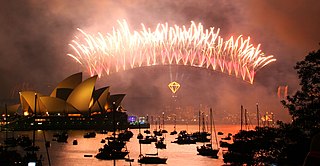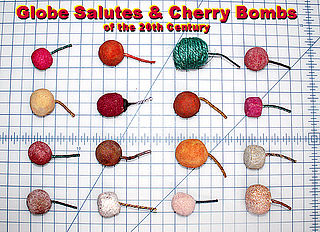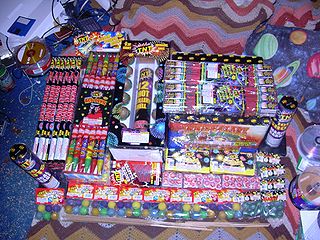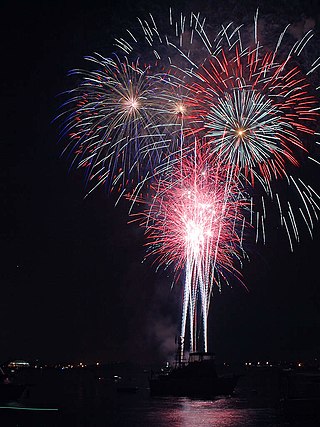
A rocket is a vehicle that uses jet propulsion to accelerate without using the surrounding air. A rocket engine produces thrust by reaction to exhaust expelled at high speed. Rocket engines work entirely from propellant carried within the vehicle; therefore a rocket can fly in the vacuum of space. Rockets work more efficiently in a vacuum and incur a loss of thrust due to the opposing pressure of the atmosphere.

A solid-propellant rocket or solid rocket is a rocket with a rocket engine that uses solid propellants (fuel/oxidizer). The earliest rockets were solid-fuel rockets powered by gunpowder; The inception of gunpowder rockets in warfare can be credited to ancient Chinese ingenuity, and in the 13th century, the Mongols played a pivotal role in facilitating their westward adoption.

Fireworks are a class of low explosive pyrotechnic devices used for aesthetic and entertainment purposes. They are most commonly used in fireworks displays, combining a large number of devices in an outdoor setting. Such displays are the focal point of many cultural and religious celebrations, though mismanagement could lead to fireworks accidents.

A model rocket is a small rocket designed to reach low altitudes and be recovered by a variety of means.

Pyrotechnics is the science and craft of creating such things as fireworks, safety matches, oxygen candles, explosive bolts and other fasteners, parts of automotive airbags, as well as gas-pressure blasting in mining, quarrying, and demolition. This trade relies upon self-contained and self-sustained exothermic chemical reactions to make heat, light, gas, smoke and/or sound. The name comes from the Greek words pyr ("fire") and tekhnikos.

A firecracker is a small explosive device primarily designed to produce a large amount of noise, especially in the form of a loud bang, usually for celebration or entertainment; any visual effect is incidental to this goal. They have fuses, and are wrapped in a heavy paper casing to contain the explosive compound. Firecrackers, along with fireworks, originated in China.

A Roman candle is a traditional type of firework that ejects one or more stars or exploding shells. Roman candles come in a variety of sizes, from 6 mm (0.24 in) diameter for consumers, up to 8 cm (3.1 in) diameter in professional fireworks displays.

A multiple rocket launcher (MRL) or multiple launch rocket system (MLRS) is a type of rocket artillery system that contains multiple launchers which are fixed to a single platform, and shoots its rocket ordnance in a fashion similar to a volley gun. Rockets are self-propelled in flight and have different capabilities than conventional artillery shells, such as longer effective range, lower recoil, typically considerably higher payload than a similarly sized gun artillery platform, or even carrying multiple warheads.

A sparkler is a type of hand-held firework that burns slowly while emitting bright, colored sparks.

In an explosive, pyrotechnic device, or military munition, a fuse is the part of the device that initiates function. In common usage, the word fuse is used indiscriminately. However, when being specific, the term fuse describes a simple pyrotechnic initiating device, like the cord on a firecracker whereas the term fuze is used when referring to a more sophisticated ignition device incorporating mechanical and/or electronic components, such as a proximity fuze for an M107 artillery shell, magnetic or acoustic fuze on a sea mine, spring-loaded grenade fuze, pencil detonator, or anti-handling device.

Flash powder is a pyrotechnic composition, a mixture of oxidizer and metallic fuel, which burns quickly (deflagrates) and produces a loud noise regardless of confinement. It is widely used in theatrical pyrotechnics and fireworks and was once used for flashes in photography.

A cherry bomb is an approximately spherical exploding firework, roughly resembling a cherry in size and shape. Cherry bombs range in size from three-quarters to one and a half inches in diameter.

Fireworks in England, Scotland and Wales are governed primarily by the Fireworks Regulations 2004, the Pyrotechnic Articles (Safety) Regulations 2015, and British Standards BS 7114 until 4/7/17 and BS-EN 15947-2015. In Northern Ireland, fireworks are governed by The Pyrotechnic Articles (Safety) Regulations 2015, and Explosives (Fireworks) Regulations (NI) 2002.

The Catherine wheel or pinwheel is a type of firework consisting either of a powder-filled spiral tube, or an angled rocket mounted with a pin through its center. When ignited, the energy of the fireworks not only create sparks and flame, but cause the wheel to quickly rotate, making the display much more spectacular. The physics of the process are those of an aeolipile.

A rocket is a pyrotechnic firework made out of a paper tube packed with gunpowder that is propelled into the air. Types of rockets include the skyrockets, which have a stick to provide stability during airborne flight; missiles, which instead rotate for stability or are shot out of a tube; and bottle rockets, smaller fireworks – 1½ in (3.8 cm) long, though the attached stick extends the total length to approximately 12 in (30 cm) – that usually contain whistle effects.

Consumer fireworks are fireworks sold for use by the general public. They are generally weaker in explosive power than the fireworks used in professional displays.

A bamboo cannon is a type of home-made firecracker which is popular during the Eid season in Malaysia and Indonesia, as well as during New Year's Eve celebrations in the Philippines.

M-80s are an American class of large powerful firecrackers, sometimes called salutes. M-80s were originally made in the mid 20th century for the U.S. military to simulate explosives or artillery fire. The "M" is designated by a U.S. military convention for "standard" equipment and "80" is for the 80 grains of flash powder within it. Later, M-80s were manufactured as consumer fireworks made from a small cardboard tube, often red, approximately 1+1⁄2 inches (3.8 cm) long and 9⁄16 inch (1.4 cm) inside diameter, with a fuse coming out of the side; this type of fuse is commonly known as cannon fuse or Visco fuse, after a company responsible for standardizing the product. This consumer version holds a reduced charge of 45 grains of pyrotechnic flash powder.
A black powder rocket motor propels a model rocket using black powder. Black powder rocket propellants consist of charcoal, sulfur, and potassium nitrate. Adjustments can be made to the amount of each component to change the rate at which the black powder burns.

Fireworks policy in the United States can be different in each jurisdiction.


























